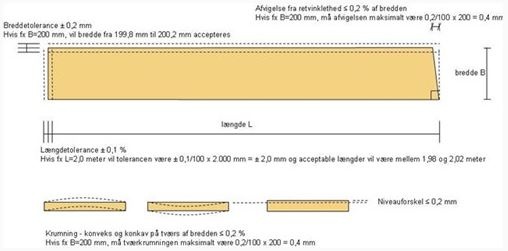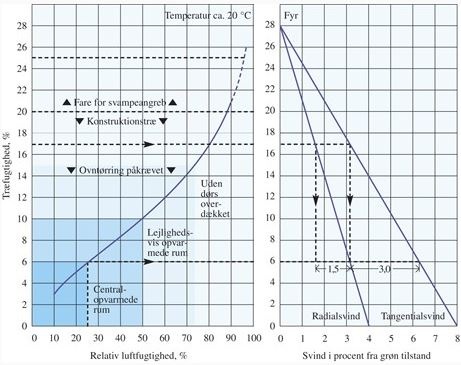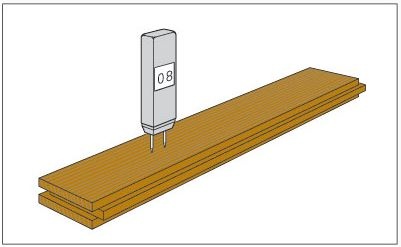- Home
- Good advice on flooring
- Floor coverings
- Wooden floors
- General conditions
- Acoustic panels
- Tailored rugs
- Bamboo floor and boards
- BeefEater gas grill
- Table tops & table legs
- Design floors
- Tiles and clinker
- Good advice on flooring
- Carpets
- Floor heating
- Grass carpets
- Cork floors
- Kitchen, bath & wardrobe
- Laminate floors
- Linoleum floors
- Paint, Tissue & Putty
- Mats
- Needle felt and fair carpets
- Furniture
- Care products
- Remainders & good offers
- Stavparket / Sildebensparket
- Carpet tiles
- Terrace boards
- Accessories
- Wooden floors
- Product samples
- Vinyl flooring
- Tool
- Other products
- Ceiling and wall panels
- Nice floors
- Pine floor
- Click floors
- Ordered goods
-
Hot41% Off
-
Hot46% Off
-
Hot25% Off
-
Hot54% Off
-
Hot54% Off
-
47% Off
General conditions
All information on this page is copied material from Gulvfakta, which is a technical reference material, Source: Gulvfakta
1.7.2.1 Sorts
1.7.2.2 Marking
1.7.2.3 Tolerances
1.7.2.4 Surface treatment
1.7.2.5 Wooden floors and moisture
1.7.2.6 Measurement of moisture content in wood and wood panels
1.7.2.7 Sound in wooden floors
All information on this page is copied material from Gulvfakta, which is a technical reference material, Source: Gulvfakta
1.7.2.1 Sorts
Wood is a natural material with many and varying properties. This is what makes it so wonderful, but also a fact that can give rise to many discussions and considerations. 2 pieces of wood from the same type of wood, wood can have significantly different appearances. There are several reasons for this.
• Tree growth conditions, in the form of differences in the soil and rainfall can affect the wood.
• Natural color differences in the tree trunk, for some types of wood, can cause very large variations in the appearance of the products made from the wood. (heartwood versus sapwood)
• The number and size of castes.
Wooden floors are therefore often supplied in different classes sorted by appearance. Sorting can be done according to classes O, □, or ∆, defined in the product standards for the individual floor types. The most common, however, is that manufacturers define their own sorting criteria, which makes comparisons between different makes difficult. In addition, surface treatment will be extremely important for the floor's overall appearance. When choosing a wooden floor, it is recommended that you ask the supplier for large representative samples. For floors that are delivered without a finished surface, it may be relevant to have a smaller test floor laid, in the sort and with the surface that you want. Reference is also made to the suppliers' information material for specific sorting classes.
1.7.2.2 Marking
Wooden floors must be CE marked.
It is the harmonized standard DS/EN 14342 "Wood floors - Characteristics, assessment of conformity and marking", which will form the basis of the CE marking, which applies to production and use in Europe. It is the manufacturer or dealer who imports the wooden floors who will be responsible for the CE marking.
The required properties appear from annex ZA in DS/EN 14342:
• Reaction in case of fire
• Release of formaldehyde
• Content of pentachorophenol
• Breaking strength (maximum load)
• Slip resistance
• Thermal conductivity
• Durability
In addition to the standard, national requirements may have been drawn up to the extent necessary to comply with building legislation.
CE marking is not a quality mark, but a harmonized standard sheet that acts as the flooring's travel passport within the European Community.
The CE mark will typically contain the following information for solid parquet boards in fire class Cfl-s1, see DS/EN 14342 - table 1:
In addition to the CE marking, all products for the construction industry must have a declaration of performance.
The performance declaration is assigned a unique number and contains information on:
1. The building product type
2. Building product identification
3. The intended use of the construction product®
4. Manufacturer's name and address
5. Name and address of authorized representative
6. Systems for assessment and control of construction product performance (Avcp)
7. Notified body(s) task(s), if relevant, including description of what they have carried out, with reference to relevant systems
FSC - Labeling.
The understanding of "the need to use wood from sustainable forestry" is gaining more and more traction among Danish consumers. The FSC scheme is one of the dominant schemes that provides this security.
When you, as a consumer or company, choose FSC, you are helping to safeguard nature and the social conditions in the forests from which the wood comes. This applies when you buy or produce products from FSC-certified wood - from garden furniture and flooring to paper and packaging.
FSC's work is based on the same 10 basic principles all over the world. On a national level, the principles are further developed/adapted with regard to local conditions.
FSC's 10 basic principles:
1. Compliance with Laws
Forest operations must comply with applicable legislation, regulations and nationally ratified international treaties, conventions and agreements.
2. Workers' rights and working conditions
Forest management must maintain or improve the social and economic conditions of those employed in the forest.
3. Rights of indigenous peoples
The organization (forest owner) must identify and recognize the legal and traditional rights of indigenous peoples to the ownership, use and use of land, territories and resources affected by the operation.
4. Relationship with the local community
The organization (forest owner) must contribute to maintaining or improving the social and economic conditions of the local community.
5. Forest services
The forest management must effectively manage the many products and services of the forest property in order to maintain or improve the long-term economic viability and the range of social and environmental services.
6. Environmental values and impacts
The organization (Forest owner) must maintain, preserve and re-establish services and environmental values from the forest ecosystem and must avoid, improve or reduce negative environmental impacts.
7. Operating plans
The organization (forest owner) must have an operations plan that is consistent with its policies and objectives and adapted to the scale, intensity and risk of operations. The operation plan must be implemented and kept up to date based on information from monitoring to promote adapted forest management. The associated procedural documentation must be sufficient to guide staff, inform affected and interested stakeholders and justify operational decisions.
8. Monitoring and assessment
The organization (forest owner) must demonstrate that progress in relation to achieving objectives, the effect of operating activities and the conditions of the operating unit are monitored and evaluated, in relation to the scale, intensity and risk of the operating activities, in order to be able to implement an adapted operation.
9. High conservation values
The organization (forest owner) must maintain and/or increase the "high conservation values" in the forest by using the precautionary principle.
10. Implementation of operational activities
Operational activities carried out by or for the forest property must be selected and implemented in accordance with the economic, environmental and social policies and objectives of the organization (forest owner) and be in accordance with the overall principles and criteria.
* The principles were revised and approved at the beginning of 2012. The Danish FSC forest standard is undergoing a revision so that it will agree with the revised principles. The current FSC forest standard is thus not based on the revised principles. If you want to know more about FSC, please refer to www.dk.fsc.org
1.7.2.3 Tolerances
Tolerances.
A wooden floor is made of a living material and during production there may also be minor tolerances. This means that with a newly laid wooden floor there may be openings between the rods/boards. The permissible production tolerances are described in a number of EN standards. The figure below shows the tolerances a board/a rod must comply with. The tolerances shown are production tolerances. And you must be aware that the dimensions of the wood are also affected by changes in humidity. This can cause changes that cause the tolerances to be exceeded.
When talking about measurements (very precise measurements) in fbm wooden floors, this is only meaningful if you have control over the surroundings. A parquet stick of 60 - 70 mm in width can change 0.5 mm in width as a result of the (permitted and expected) changes in the moisture content of the air.
See also section "Wood and moisture".
The above is important to bear in mind when assessing the result, the quality, of a newly laid floor. It is also important to emphasize the following; The assessment of a wooden floor must be carried out standing (at a height of approx. 160 cm) with the light behind.
1.7.2.4 Surface treatment
Surface treatment including sanding is described under maintenance, click here to read more
1.7.2.5 Wooden floors and moisture
When designing and laying wooden floors, account must be taken of the inevitable dimensional changes that will occur as a result of changes in the surroundings where the wooden floor is located. The moisture content of the air varies over the year, this affects wooden floors. Figure 1 shows how the absolute humidity of the air and the relative humidity of the air vary over the year,
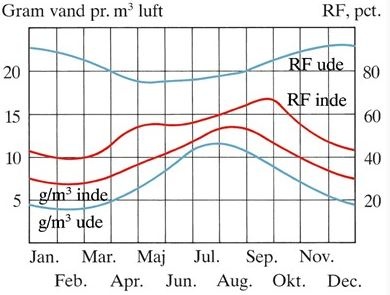
Wood is an organic material and generally consists of different types of cells. In a living state, the cells and cell walls are filled with water and there is a constant transport of water, via the cells, around the tree. When the wood collectively stops the water transport and water in the cell walls dries out, the drying process stops when an equilibrium state has been reached between the moisture in the wood and the moisture in the surrounding air. The cells in the "dead" wood can also absorb moisture from the air if the air contains more water than the wood does, whereby a new state of equilibrium occurs. In connection with the absorption and release of water to the surroundings, the tree changes dimension. When it absorbs moisture it grows (suffocates), when it releases moisture it shrinks, it becomes smaller. It is this process that you have to keep in mind when designing and laying wooden floors.
Figure 2: The moisture equilibrium curve/sorption curve (on the left) shows the relationship between the relative humidity at approx. 20C, and the curve on the right shows the calculation of shrinkage when changing the equilibrium humidity. The speed with which the water is absorbed/released in the wooden floor can be affected by giving the wood an overcharge treatment. The denser the surface treatment you give the wooden floor, the slower it reacts. In addition, the thickness of the floor is also an important parameter. Thick boards/poles take longer to reach equilibrium moisture than thin boards/poles.
The moisture-related dimensional change is not the same in the main directions of the wood.
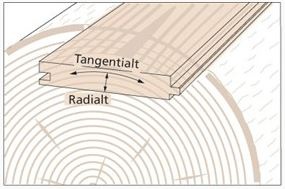
Normally, the tangential shrinkage is about twice as great as the radial shrinkage and the axial shrinkage is only between 1/10 and 1/20 of the radial, which is why this is often disregarded. Furthermore, there will be differences in density between wood from the root of the tree and the top of the tree. This difference also affects the shrinkage.
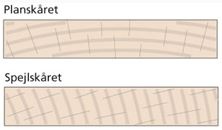
Shrinkage and expansion in wood depends on the cut/grain location.
A number of the types of wood most used for flooring (pine, beech, oak and ash) react as follows: A change in the wood's moisture content of 1 percent will result in a change of approx. 0.15% radially and 0.30% tangentially. In practice, wood for packet/plank floors is a mixture between flat-cut and mirror-cut units, and an average figure of 0.22% or 2.2 mm/m is therefore used for each percentage of wood
Example 1.
A parquet floor with 65 mm wide rods is delivered from the factory with an average moisture content of 8%. The floor is laid in early summer at 20 C and a relative humidity of approx. 40% in a room that is 4 meters wide. During the summer, it is expected that the relative humidity of the air will rise to 65%. This will cause the average moisture content of the parquet sticks to rise to approx. 13% (see figure G2), i.e. with approx. 5% relative to the moisture content at the time of laying. This increase in moisture will cause the parquet bars to expand by 5x0.22%x65mm=0.7 mm on average. Measured over the entire width of the room, the parquet floor will thus expand by 4000/65x0.7 = 43 mm due to the change in the moisture content of the air
The importance of moisture for wooden floors
When choosing and installing wooden floors, account must be taken of the inevitable changes in dimensions as a result of the seasonal variations in humidity. Joints between floorboards cannot be avoided, but by choosing the floor, the size of future joints can be limited. joints are used here in the sense of openings between boards or rods in the floor.
The joint size can be reduced by:
• Use narrow boards instead of wide ones, because the joint width follows the board width.
• Choose products with little dimensional change due to moisture.
• Control the climate, e.g. with moderate humidification in office buildings in winter to avoid drying out.
• Refrain from using underfloor heating systems or radiant heating in ceilings.
• The joints are therefore relatively large, and in practice the joints will also often be of different sizes, which causes a great risk of an unsatisfactory appearance.
Note that if a 180 mm wide floorboard had been used instead, the joints would instead be approx. 1,2 and 4 mm.
Example 2
A traditional pine floor has 18 boards per 2 meters. The floorboards are laid without gaps. After a few months, there are spaces between the boards of varying sizes from 0 to 5 mm. The 17 spaces are measured with a leaf finder to have a total width of 48 mm. 48 mm at 2 meters corresponds to a shrinkage of 2.4%. With an average lateral shrinkage of 0.22% for every one percentage change in moisture, it takes (2.4% : 0.22%) = 11% change in the moisture content of the boards to produce a shrinkage of 2.4%. Since the current wood moisture is 7%, the floorboards had a moisture content of approximately 18% when they were laid.
10-board goal
When laying a solid wooden floor, it must be ensured that the wooden floor is given the opportunity to absorb moisture movements. This is often done by laying out the wooden floor according to a 10-board measure, which indicates the width 10 boards or sticks are expected to have in the most humid state of use. The most humid period is usually the winter, when the average moisture content in the air can reach 65% RH with a consequent moisture content in the wood of 12 - 13%, however depending on the wood species etc.
In example 1 , we calculated that an ordinary parquet rod of 60 - 70 mm expands approx. 0.7 mm per rod by moistening from the moisture content with which the rods are normally expected to be delivered, to the equilibrium moisture it must be expected in the wettest period. Many floors do not reach an equilibrium humidity of 12-13%.
1.7.2.6 Measurement of moisture content in wood and wood panels
The most common method for measuring moisture in wood is electrical resistance measurement between two electrodes which are inserted into the wood, see figure 7. The method is based on the fact that the resistance between the electrodes is dependent on the wood's moisture content. There are many makes but only two main types of instruments.
Fig. 7. Measurement of wood moisture with electrical resistance meter. The measurement is based on measuring the resistance between two electrodes (legs) which are inserted into the tree. It must be measured lengthwise along the veins and at least 300 mm from the end timber.
One type has insulated electrodes, so that only the tip of the electrodes is measured. This can be an advantage because there are no disturbances, e.g. due to condensation on the surface. The second type of instrument has uninsulated electrodes and is usually cheaper and easier to work with. Measurements must be made lengthwise along the veins and not across cams or near nails or screws. Most instruments directly indicate the moisture content in percent by weight. Normally, the instruments are calibrated to measure in pine and spruce, and corrections must be made when measuring in other materials, just as corrections must be made at temperatures that deviate significantly from 20°C. Since pressure impregnation agents can change the conductivity of the wood, measurements in pressure-impregnated wood will give misleading results.
1.7.2.7 Sound in wooden floors
Tension sounds in a wooden floor can occur, and are heard as minor crunching or creaking sounds. This is completely normal for a wooden floor. Sounds can be different from season to season, as the wood expands and contracts according to temperature and humidity.
In late summer, the relative humidity is high in our homes, and therefore the moisture content in the wooden floor also increases. The increased humidity means that the floor expands and may buckle, which can result in seasonal creaking noises when the floor is walked on. Most of the time, the natural sounds disappear again when the heating season starts and the relative humidity stabilizes.
In old plank floors on joists, the creaking noises can also be caused by wear and repeated floor sanding. The ferrule may have been damaged, so that two neighboring boards unintentionally move a lot in relation to each other, thereby creating annoying noises when you step on the floor. Likewise, the supporting beams under the boards may have sunk, or the boards may have been sanded so many times that the boards move in the nail holes when the floor is walked on. A damaged rafter is difficult to repair, while there are various methods to limit the movement of the boards in the nail holes.
New floors are most often laid as floating floors, where there can be no sounds from nail holes. Depending on changes in the relative humidity and the temperature in the room, minor creaking noises may occur, which is completely normal. In cases where the creaking sounds are constant and bothersome, the cause may possibly be due to a crooked or yielding subfloor, where unacceptable gaps or elevations in the subfloor create the sounds when the floor is loaded.
There are no standards or other rules for how much a wooden floor can creak, but a wooden floor should never be expected to be silent in normal use.











